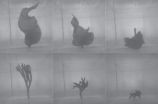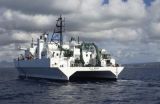(Press-News.org) Seaweeds are important foundational species that are vital both as food and habitat to many aquatic and terrestrial shore organisms. Yet seaweeds that cling to rocky shores are continually at risk of being broken or dislodged from their holds by crashing waves with large hydrodynamic forces. So how do such seaweeds survive in intertidal zones? Do they have special properties that make them extremely flexible or particularly strong?
Patrick Martone (University of British Columbia) has spent a considerable amount of time standing on the shore watching big waves crash against intertidal rocks and wondering how the seaweeds—or anything else—manage to survive there.
"Many animals can run and hide when storms roll in and the waves increase," Martone observes. "But seaweeds don't have that option; they have to just hold on tight and face the waves head-on."
Indeed, the drift algae that pile up on the beach after a big storm suggest that not all algae are able to survive such onslaughts.
"So what is special about the ones that do survive?"
Previous research has found that one solution seaweeds have come up with is flexibility. Blades of seaweed may curl up and branches may collapse, thereby changing the shape of the seaweed and reducing drag as water velocity increases. But different seaweeds may utilize different strategies to effectively reduce drag, such that some may be better at changing shape and others at reducing size. Martone and colleagues from Stanford University and St. John Fisher College were interested in teasing apart some of these variables and published their findings recently in the American Journal of Botany.
By exploring the dynamics of size and shape changes of intertidal seaweeds at different rates of water flow, Martone and co-authors hoped to better understand the various strategies that have led to the morphological diversity in macroalgae seen along wave-swept shores.
The authors collected fronds from six different species of algae (four branched, two bladed) along the intertidal zone of the central Californian coast, placed them in a recirculating water flume, and measured the drag they experienced and the changes in shape and size they underwent under 15 different rates of water flow, ranging from 0 to 4 m/sec.
Interestingly, they found that while all six species of seaweed underwent severe reconfiguration as water velocity increased—thus limiting the drag they would otherwise experience if they were rigid—the two types of algae accomplished this in slightly different ways.
"Unbranched algae seem to be 'shape changers,' reducing drag primarily by folding and collapsing in flow," notes Martone. "Certain branched algae, on the other hand, are 'area reducers,' compensating for drag-prone shapes by reducing frond size through branch reorientation and compression. Thus, we demonstrate that flexibility acts in two distinct ways: permitting wave-swept algae to change shape and to reduce frond area projected into the flow."
Martone and colleagues also wanted to see how accurately responses at slow speeds of water flow could be extrapolated to what happens at higher speeds, such as what the seaweeds might be experiencing along the shore.
"Most structural engineers have it easy," Martone says. "Studying air flow around airplane wings or water flow around bridges is relatively straightforward, since these man-made structures are rigid and do not deform in flow. Seaweeds are more complicated because they are flexible. As flow speeds increase, flexible seaweeds re-orient and reconfigure, changing size and shape to reduce drag, making predictions much more difficult."
Indeed, the authors found that measurements extrapolated out from lower speeds did not always match those observed at higher speeds, making it tricky to predict what would happen at higher water velocities. Moreover, in the experimental water flume seaweeds may have more time to react to water speeds that are relatively slow compared with breaking waves—a condition whereby fast reaction times may be crucial for reconfiguring and reducing drag.
"Understanding how selection can act on the ability to change shape or the ability to reduce size in flow may give us insight into the morphological evolution of intertidal algae," summarizes Martone.
Martone concludes that further investigation is still needed to tease these features apart: "We have started building flexible models of branched and unbranched seaweeds in the lab to explore how precise changes in branching affect drag. We hope this work will help us better understand how waves have sculpted seaweeds over evolutionary time."
INFORMATION:
Patrick T. Martone, Laurie Kost, and Michael Boller. 2012. Drag reduction in wave-swept macroalgae: Alternative strategies and new predictions. American Journal of Botany 99(5): 806-815. DOI: 10.3732/ajb.1100541
The full article in the link mentioned is available for no charge for 30 days following the date of this summary at http://www.amjbot.org/content/99/5/806.full.pdf+html. After this date, reporters may contact Richard Hund at ajb@botany.org for a copy of the article.
The Botanical Society of America is a non-profit membership society with a mission to promote botany, the field of basic science dealing with the study and inquiry into the form, function, development, diversity, reproduction, evolution, and uses of plants and their interactions within the biosphere. It has published the American Journal of Botany for nearly 100 years. In 2009, the Special Libraries Association named the American Journal of Botany one of the Top 10 Most Influential Journals of the Century in the field of Biology and Medicine.
For further information, please contact the AJB staff at ajb@botany.org.
New research on seaweeds shows it takes more than being flexible to survive crashing waves
Bladed and branched algae adapted to strong wave conditions are able to reconfigure their shape and size
2012-05-11
ELSE PRESS RELEASES FROM THIS DATE:
You're beautiful, Vesta
2012-05-11
When UCLA's Christopher T. Russell looks at the images of the protoplanet Vesta produced by NASA's Dawn mission, he talks about beauty as much as he talks about science.
"Vesta looks like a little planet. It has a beautiful surface, much more varied and diverse than we expected," said Russell, a professor in UCLA's Department of Earth and Space Sciences and the Dawn mission's principal investigator. "We knew Vesta's surface had some variation in color, but we did not expect the diversity that we see or the clarity of the colors and textures, or their distinct boundaries. ...
A push from the Mississippi kept Deepwater Horizon oil slick off shore, Penn research shows
2012-05-11
PHILADELPHIA — When the Deepwater Horizon drilling rig exploded April 20, 2010, residents feared that their Gulf of Mexico shores would be inundated with oil. And while many wetland habitats and wildlife were oiled during the three-month leak, the environmental damage to coastal Louisiana was less than many expected, in part because much of the crude never made it to the coast.
Research by a trio of geoscientists, including the University of Pennsylvania's Douglas Jerolmack, now offers an explanation for why some of the oil stayed out at sea. Using publicly available ...
NASA's IBEX reveals a missing boundary at the edge of the solar system
2012-05-11
For the last few decades, space scientists have generally accepted that the bubble of gas and magnetic fields generated by the sun – known as the heliosphere – moves through space, creating three distinct boundary layers that culminate in an outermost bow shock. This shock is similar to the sonic boom created ahead of a supersonic jet. Earth itself certainly has one of these bow shocks on the sunward side of its magnetic environment, as do most other planets and many stars. A collection of new data from NASA's Interstellar Boundary Explorer (IBEX), however, now indicate ...
First forecast calls for mild Amazon fire season in 2012
2012-05-11
Forests in the Amazon Basin are expected to be less vulnerable to wildfires this year, according to the first forecast from a new fire severity model developed by university and NASA researchers.
Fire season across most of the Amazon rain forest typically begins in May, peaks in September and ends in January. The new model, which forecasts the fire season's severity from three to nine months in advance, calls for an average or below-average fire season this year within 10 regions spanning three countries: Bolivia, Brazil and Peru.
"Tests of the model suggested that ...
HPV vaccine completion rate among girls is poor, getting worse
2012-05-08
GALVESTON, Texas – April 30, 2012 – The proportion of insured girls and young women completing the human papillomavirus (HPV) vaccine among those who initiated the series has dropped significantly – as much as 63 percent – since the vaccine was approved in 2006, according to new research from the University of Texas Medical Branch (UTMB) in Galveston.
The study, published in the current issue of Cancer, reveals the steepest decline in vaccine completion among girls and young women aged nine to 18 – the age group that derives the greatest benefit from the vaccine, which ...
Higher risk of birth defects from assisted reproduction
2012-05-08
VIDEO:
Associate professor Michael Davies (Robinson Institute, University of Adelaide) discusses the findings of a study into the risk of major birth defects associated with assisted reproductive technologies.
Click here for more information.
A University of Adelaide study has identified the risk of major birth defects associated with different types of assisted reproductive technology.
In the most comprehensive study of its kind in the world, researchers from the University's ...
GPS on commercial ships could improve tsunami warnings
2012-05-08
Commercial ships travel across most of the globe and could provide better warnings for potentially deadly tsunamis, according to a study published May 5 by scientists at the University of Hawaii – Manoa (UHM) and the National Oceanic and Atmospheric Administration's Pacific Tsunami Warning Center.
James Foster, lead author and Assistant Researcher at the UH School of Ocean and Earth Science and Technology (SOEST), and colleagues were able to detect and measure the properties of the tsunami generated by the magnitude 8.8 earthquake in Maule, Chile (February 2010), even ...
US Army examines why some soldiers avoid PTSD care, strategies to keep them in treatment
2012-05-08
PHILADELPHIA, May 5, 2012 – U.S. Army researcher Maj. Gary H. Wynn, M.D., shared new analysis on why some Soldiers suffering from combat-related post-traumatic stress disorder (PTSD) never seek care or drop out of treatment early during a presentation today at the American Psychiatric Association's annual meeting. His presentation, "Epidemiology of Combat-Related PTSD in U.S. Service Members: Lessons Learned," also described the approaches the Army is using to address this issue and improve overall patient outcomes.
Currently, fewer than half of the Soldiers who report ...
A new candidate pathway for treating visceral obesity
2012-05-08
BOSTON, MA—Brown seems to be the color of choice when it comes to the types of fat cells in our bodies. Brown fat expends energy, while its counterpart, white fat stores it. The danger in white fat cells, along with the increased risk for diabetes and heart disease it poses, seems especially linked to visceral fat. Visceral fat is the build-up of fat around the organs in the belly.
So in the battle against obesity, brown fat appears to be our friend and white fat our foe.
Now a team of researchers led by Jorge Plutzky, MD, director of The Vascular Disease Prevention ...
Diabetic retinopathy research could reduce screening costs
2012-05-08
Research carried out at the Peninsula College of Medicine and Dentistry (PCMD), University of Exeter, has concluded that it would be a safe and cost-effective strategy to screen people with type 2 diabetes who have not yet developed diabetic retinopathy, for the disease once every two years instead of annually.
The research is supported by funding from the National Institute for Health Research Peninsula Collaboration for Leadership in Applied Health Research and Care (NIHR PenCLAHRC). It is published today (00:01hrs BST Monday 7th May 2012) on-line in Diabetes Care.
Diabetic ...
LAST 30 PRESS RELEASES:
The Ceramic Society of Japan’s Oxoate Ceramics Research Association launches new international book project
Heart-brain connection: international study reveals the role of the vagus nerve in keeping the heart young
Researchers identify Rb1 as a predictive biomarker for a new therapeutic strategy in some breast cancers
Survey reveals ethical gaps slowing AI adoption in pediatric surgery
Stimulant ADHD medications work differently than thought
AI overestimates how smart people are, according to HSE economists
HSE researchers create genome-wide map of quadruplexes
Scientists boost cell "powerhouses" to burn more calories
Automatic label checking: The missing step in making reliable medical AI
Low daily alcohol intake linked to 50% heightened mouth cancer risk in India
American Meteorological Society announces Rick Spinrad as 2026 President-Elect
Biomass-based carbon capture spotlighted in newly released global climate webinar recording
Illuminating invisible nano pollutants: advanced bioimaging tracks the full journey of emerging nanoscale contaminants in living systems
How does age affect recovery from spinal cord injury?
Novel AI tool offers prognosis for patients with head and neck cancer
Fathers’ microplastic exposure tied to their children’s metabolic problems
Research validates laboratory model for studying high-grade serous ovarian cancer
SIR 2026 delivers transformative breakthroughs in minimally invasive medicine to improve patient care
Stem Cell Reports most downloaded papers of 2025 highlight the breadth and impact of stem cell research
Oxford-led study estimates NHS spends around 3% of its primary and secondary care budget on the health impacts of heat and cold in England
A researcher’s long quest leads to a smart composite breakthrough
Urban wild bees act as “microbial sensors” of city health.
New study finds where you live affects recovery after a hip fracture
Forecasting the impact of fully automated vehicle adoption on US road traffic injuries
Alcohol-related hospitalizations from 2016 to 2022
Semaglutide and hospitalizations in patients with obesity and established cardiovascular disease
Researchers ‘listen in’ to embryo-mother interactions during implantation using a culture system replicating the womb lining
How changing your diet could help save the world
How to make AI truly scalable and reliable for real-time traffic assignment?
Beyond fragmented markets: A new framework for efficient and stable ride-pooling
[Press-News.org] New research on seaweeds shows it takes more than being flexible to survive crashing wavesBladed and branched algae adapted to strong wave conditions are able to reconfigure their shape and size



